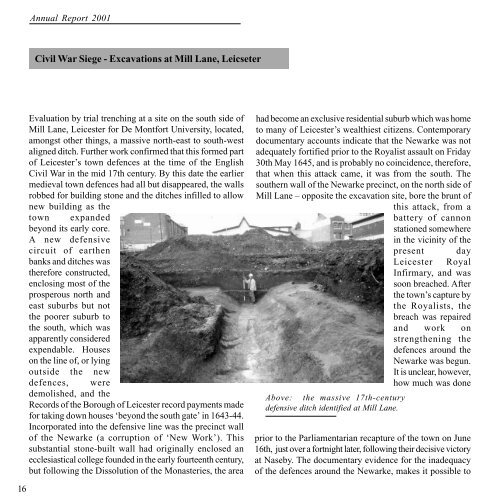2001_000
2001_000
2001_000
Create successful ePaper yourself
Turn your PDF publications into a flip-book with our unique Google optimized e-Paper software.
Annual Report <strong>2001</strong><br />
Civil War Siege - Excavations at Mill Lane, Leicseter<br />
16<br />
Evaluation by trial trenching at a site on the south side of<br />
Mill Lane, Leicester for De Montfort University, located,<br />
amongst other things, a massive north-east to south-west<br />
aligned ditch. Further work confirmed that this formed part<br />
of Leicester’s town defences at the time of the English<br />
Civil War in the mid 17th century. By this date the earlier<br />
medieval town defences had all but disappeared, the walls<br />
robbed for building stone and the ditches infilled to allow<br />
new building as the<br />
town expanded<br />
beyond its early core.<br />
A new defensive<br />
circuit of earthen<br />
banks and ditches was<br />
therefore constructed,<br />
enclosing most of the<br />
prosperous north and<br />
east suburbs but not<br />
the poorer suburb to<br />
the south, which was<br />
apparently considered<br />
expendable. Houses<br />
on the line of, or lying<br />
outside the new<br />
defences, were<br />
demolished, and the<br />
Records of the Borough of Leicester record payments made<br />
for taking down houses ‘beyond the south gate’ in 1643-44.<br />
Incorporated into the defensive line was the precinct wall<br />
of the Newarke (a corruption of ‘New Work’). This<br />
substantial stone-built wall had originally enclosed an<br />
ecclesiastical college founded in the early fourteenth century,<br />
but following the Dissolution of the Monasteries, the area<br />
had become an exclusive residential suburb which was home<br />
to many of Leicester’s wealthiest citizens. Contemporary<br />
documentary accounts indicate that the Newarke was not<br />
adequately fortified prior to the Royalist assault on Friday<br />
30th May 1645, and is probably no coincidence, therefore,<br />
that when this attack came, it was from the south. The<br />
southern wall of the Newarke precinct, on the north side of<br />
Mill Lane – opposite the excavation site, bore the brunt of<br />
this attack, from a<br />
battery of cannon<br />
stationed somewhere<br />
in the vicinity of the<br />
present day<br />
Above: the massive 17th-century<br />
defensive ditch identified at Mill Lane.<br />
Leicester Royal<br />
Infirmary, and was<br />
soon breached. After<br />
the town’s capture by<br />
the Royalists, the<br />
breach was repaired<br />
and work on<br />
strengthening the<br />
defences around the<br />
Newarke was begun.<br />
It is unclear, however,<br />
how much was done<br />
prior to the Parliamentarian recapture of the town on June<br />
16th, just over a fortnight later, following their decisive victory<br />
at Naseby. The documentary evidence for the inadequacy<br />
of the defences around the Newarke, makes it possible to





